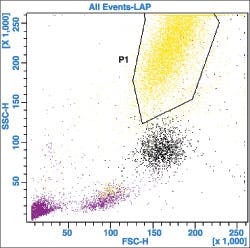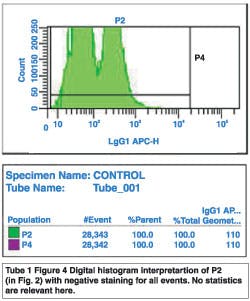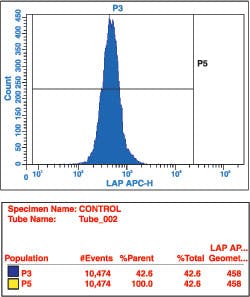Can a clinical LAP procedure be made reproducible and easy to perform?
Leukocyte alkaline phosphatase (LAP) aids in the
differentiating diagnoses of chronic myelogenous leukemia vs. leukamoid
reaction; evaluates polycythemia vera and helps to differentiate
myelofibrosis, myeloid metaplasia, and paraxysomal nocturnal
hemoglobinuria.1 For detecting LAP, the gold standard uses an
enzymatic reaction in which LAP-liberating naphthol couples with Fast
Blue RR Salt (Sigma-Aldrich)2 to form an insoluble dark blue
precipitate over neutrophils containing alkaline phosphatase activity.
Granulocyte (polymorphonuclear cells, or PMNs, alkaline phosphatase
activity is scored from 0 to 4+ on the basis of the precipitate. The
final score is based on counting and evaluation of 100 PMNs.
For the 35 years prior to 2006, our medical facility
used the Sigma-Aldrich histochemical semiquantitative method for
demonstrating LAP. The procedure has numerous chemical risks and
potential health hazards. Other variables in the methodology — including
the subjective rating of stained cells — made this procedure less
reproducible. The package insert for the Sigma-Aldrich Fast Blue RR Salt
lists several additional possible variables.
The quest
In 2006, we began a quest to locate and develop a
simple, effective, and reproducible procedure which would decrease the
variables in the histochemical procedure, using flow cytometry (FCM). We
located an antihuman/mouse/rat bone/leukocyte alkaline phosphatase
antibody which recognizes alkaline phosphatase on cell surfaces. Using
this antibody, we evaluated alkaline phosphatase expression by FCM.
Our procedure was first implemented in four-color
with the Cellquest program on the analog-based Becton Dickinson (BD)
FacsCalibur, where results compared well with histochemical results and
were additionally very reproducible. There are no variations in the test
set-up among medical technologists or within the program on the
FacsCalibur. In late 2007, the FacsCaliber was replaced by the BD
FacsCANTO II and analog reporting of results was
converted to digital interpretation in DIVA software 5.0.2. Again,
reproducible results were obtained; and normal ranges were
re-established to the improved instrument technology.
Sample requirement and preparation: sample and control
The patient sample of choice is whole blood in an
unspun sodium (Na) Heparin green-top (BD catalog #8019579) Vacutainer
with no gel, in which blood is stable for 24 hours. No stable commercial
control product exists to show normal, increased, or decreased LAP in
PMNs. A sodium EDTA Vacutainer tube of whole blood was selected as a
control from our patient population possessing a normal to increased
absolute PMN population. EDTA does not show reproducible results for
patient use and is restricted to quality control (QC) in demonstrating
the “stained,” “unstained,” dim and bright cell populations. National
Committee for Clinical Laboratory Standards also discourages use of EDTA
on patient samples.3
Preparation of packed cell volume
Labeled 3-mL to 4-mL samples of control and patient
whole blood were each washed twice with Sigma phosphate-buffered saline
(PBS) in 10-mL patient-labeled Falcon tubes, and spun at 1,200 rpm for
seven minutes. Samples remain as a packed-cell volume with near all the
PBS removed by non-invasive aspiration leaving WBCs. Each sample is then
lightly vortexed.
Monoclonal antibody requirements
Each patient or control test consists of two tubes:
Tube 1: (Isotope control tube): Contains 10-uL
each of monoclonals anti-CD45 PerCP (for gating granulocytes)
Anti-IgG1/IGg2a FITC/PE, and 5-uL Anti-IgG1 APC.
Tube 2: (Test tube): Contains 10 uL each of
anti-CD45 PerCP, anti-CD14 FITC, anti-CD11b PE, and 5-uL anti-LAP-APC.
LAP-APC monoclonal, antihuman/mouse/rat bone (R&D Catalog #FAB1448A,
clone B4-78) is supplied by R&D
Systems. All other monoclonals are supplied by eBioscience or BD.
Methodology/procedure
Into each of the two tubes containing monoclonals
(Tubes 1 and 2) is placed 100 uL washed, packed cells from the
appropriate control or patient. After light mixing by vortex, the tubes
are incubated at room temperature for 30 minutes in the dark. After the
initial incubation, the cells are lysed with BD FacsLYSE, 10% Working
Solution and incubated in the dark at room temperature for 10 minutes.
Following the second incubation, all tubes are
centrifuged at 1,200 rpm for seven minutes; lyse supernatant is
decanted, and the resuspended pellets are washed with 10% Sigma
buffered-PBS solution. The resulting washed, centrifuged, and remaining
pellet is resuspended with 5% Polyscience Formalin working solution.
Samples may be read immediately, however, are stable for 24 hours if
stored at 2^0C to 8^0C in the dark.
Test analysis
Tube 1: In
Diva 5.0.2, a global worksheet form is used. The first dot plot (see
Figure 1) consists of a FSC-H/SSC-H linear dot plot via corrected
compensation for Anti-LAP-APC. The P1 population of interest is gated on
the FSC-H/SSC-H (forward scatter height and side scatter height)
granulocyte population with a collection of near 10,000 events. All
events are displayed on the dot plot. All events are additionally
populated in an X -Y 5 log-decade dot plot to a P2 FITC/PE (fluorescein
isothiocyanate/phycoerythrin) negative stained isotype control and a P3
population which is negative for all events (see Figure 2 and Figure 2
statistics).
Four quad-divided dot plots showing pure negative
populations of anti-IgG2a PE-H (Y axis), anti-IgG1 APC-H (X axis),
anti-IgG1 FITC-H (X axis), and anti-IgG1 APC-H (Y axis) (see Figures 3a
and 3b). On all events, no statistics are necessary as this is a visual
confirmation of gate placement (internal quality control).
Figure 4 is the digital histogram interpretation of
P2 population (see Figure 2) showing negative staining of all events. No
statistics are relevant here.
Figure 5 is the digital histogram interpretation of
P3 (see Figure 2) showing no population in the gate and also not
including any part of P2. No statistics are relevant here.
Tube 2: Events and populations are interpreted in
the following figures given that P1 is gated on granulocytes (PMNs)
based on linear FSC-H/SSC-H and P2 is gated on negative isotype
monoclonal controls. P3 now becomes a separate gate on bright CD11b+/
dim CD14+ granulocytes. Bright CD11b+/CD14+ monocytes are not populated.
Continuing on the global worksheet (see Figure 6),
the P1 granulocyte gate remains intact from the gate on Tube 1. No
adjustment is made on the P1 population. The events counted remain at
10,000 in the P1 gate. All histograms and dot plots continue to show all
events.
The P2 population (see Figure 7) remains on the
negative events but now in Tube 2 includes dim intensity CD11b PE+
lymphocytes. Bright CD11bPE/dim CD14 FITC-H granulocytes are gated in
P3, while bright CD11b+/CD14+ monocytes are ignored and not gated.
While in Tube 1, Figures 3a and 3b showed negative
isotype controls; in Tube 2, the brighter CD11b and CD14 are shown
against LAP (see Figures 8a and 8b).
In Tube 2, the P4 histogram and statistics display
the true P2 negative population (see Figure 9), which is the dim CD11b
positive lymphocytes and their geometric mean is displayed as units.
In Tube 2, the P5 histogram and statistics display
the true P3 bright positive of CD11b+/LAP+ granulocytes (see Figure 10).
Statistics and clinical resulting LAP values are shown with the
geometric mean displayed as units.
Normal range evaluation
Using our clinical laboratory personnel as a normal
population, 35 unspun NaHeparin samples were collected and evaluated
using the aforementioned worksheet on the LAP template created in DIVA
Software 5.0.2. There were no outliers. Best fit = Log Gaussian
Distribution where +/- 2SD gave our population a normal range of 258
units to 585 units LAP.
Closing discussion
Measurement of LAP activity is routinely used for the
laboratory diagnosis of various hematological disorders. The
gold-standard enzymatic methodology of LAP detection called the “LAP
score” is semiquantitative, laborious, and subject to great
inter-observer and inter-laboratory variability.
In our laboratory, we used alkaline phosphatase
antibody in conjunction with CD45, CD11b, and CD14 to quantitate surface
LAP by flow cytometry, which provides the advantage of specifically
evaluating granulocytes by using forward and side scatter. In addition,
dim expression of CD14 on the granulocytes helps to separate them from
bright CD14 positive monocytes.
Moreover, each assay has an in-built negative control
of dim CD11b-positive/CD14-negative lymphocytes, which lack expression
of alkaline phosphatase. Thus, in our routine testing we have
implemented flow-cytometric methodology of LAP detection, which is
simple, quantitivative, and reproducible.
In the Department of Pathology and Laboratory
Medicine at James A. Haley Veterans Administration Hospital in Tampa,
FL, Edna M. Hanson, MT (ASCP),
is a technical specialist working with
Steven J. Agosti, MD,
F(CAP), F(ASCP),
assistant chief of Pathology, and
Loveleen C. Kang, MD,
chief of Flow Cytometry, who is also associate professor of Pathololgy
and Cell Biology at the University of Florida-Tampa.
References
- Rambaldi A, Masuhara K, Borleri GM, et al. Flow
cytometry of leukocyte alkaline phosphatase in normal and pathological
leukocytes. British Journal of Hematology. 1997;96:815-822. - Leukocyte Procedure No. 86. (AP) [package insert].
Sigma-Aldrich Corp., St. Louis, MO. - Proposed standard: Histochemical Method for Leukocyte Alkaline
Phosphatase H22-P, Vol 4, No.14, National Committee for Clinical
Laboratory Standards.











